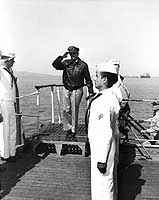
North Korea's summer offensive was brought to an abrupt end on 15 September 1950 with a daring amphibious landing at Inchon. Within a few days, the much-battered North Korean army was disintegrating as it retreated from the Pusan perimeter, pursued by the U.N. Eighth Army. Seoul was liberated by month's end. In October, a further amphibious operation directed against the east coast port city of Wonsan was overtaken by events, as the South Korean army pushed into the objective area well before the planned landing date.
U.N. ground forces, still largely made up of U.S. and South Korean troops, moved north along the Korean east coast, through the center of the peninsula and up into its western parts from Seoul, constrained more by logistics problems than by enemy resistance. Though hampered by severe shortages of mine clearance assets, the Navy opened new ports at Chinnampo on the west coast and Wonsan, Hungnam, Iwon and Songjin in the east. Supplies and fresh forces from across the Pacific, so sparse in July, were by now arriving in abundance. President Truman and other dignitaries came west to confer and to see for themselves.
Offshore, four U.S. fleet aircraft carriers, smaller U.S. and British carriers, several cruisers and numerous destroyers hurled airborne weapons and naval gunfire wherever enemy targets could be found. The available firepower was so abundant that some ships, rushed out during the summer crisis, were released to return home for a well-deserved rest or returned to their normal duties.
A United Nations' resolution offered a mandate to reunify Korea from the south, and General MacArthur willingly complied. However, his troops were thin on the ground in North Korea, with the separate spearheads too separated by distance and the rugged terrain to provide mutual support. From Communist China came threats of intervention, unfortunately discounted by MacArthur's intelligence, as the Chinese intent was real and was backed by battle-hardened ground forces and a Soviet promise of covering air power.
By early November, U.S. and South Korean troops had fought Chinese units, capturing prisoners and discovering that the new enemy was a tough one. Aerial reconnaissance reported much military traffic southbound from Manchuria. MacArthur was concerned enough to begin bombing attacks against bridges over the Yalu, but retained his optimism that a final offensive in late November would quickly bring the War to a successful conclusion.
This page features a special selection of images related to the U.N. offensive period of the Korean War, from 15 September to 25 November 1950, and provides links to additional pictorial coverage of that time.
For additional special selections of images of this period of the Korean War, with links to broader coverage, see:
For more images of other aspects of the United Nations'
Offensive period of the Korean War, see:
For a precis of our Korean War images, and links to more
comprehensive pictorial coverage of that conflict, see:
| If you want higher resolution reproductions than the Online Library's digital images, see: How to Obtain Photographic Reproductions. |
Click on the small photograph to prompt a larger view of the same image.
|
Photo #: 80-G-422387 Douglas AD "Skyraider" attack planes From USS Valley Forge (CV-45), fire 5-inch rockets at a North Korean field position. Photo is dated 24 October 1950. Official U.S. Navy Photograph, now in the collections of the National Archives. Online Image: 153KB; 740 x 615 pixels Reproductions of this image may also be available through the National Archives photographic reproduction system. |
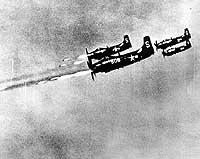 |
|
Photo #: 80-G-423495 Attacks on Yalu River Bridges, November 1950 Yalu River bridges at Sinuiju, North Korea, under attack by planes from USS Leyte (CV-32). Three spans have been dropped on the highway bridge, but the railway bridge (lower bridge) appears to be intact. The Manchurian city of Antung is across the river, in upper right. Photograph is dated 18 November 1950, but may have been taken on 14 November. Compare bomb damage on and around the river embankment, in the lower part of this photo, with that in Photo # 80-G-422115, which was taken earlier. Official U.S. Navy Photograph, now in the collections of the National Archives. Online Image: 140KB; 740 x 620 pixels Reproductions of this image may also be available through the National Archives photographic reproduction system. |
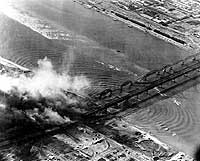 |
|
Photo #: 80-G-K-12603 (Color) USS Missouri (BB-63) Fires a salvo of 16-inch shells from turret # 2 while bombarding Chongjin, North Korea, in an effort to cut enemy communications, October 1950. Chongjin is only 39 miles from North Korea's northern border. This is a color-tinted version of a black & white original. The original photograph is Photo #: 80-G-421049. Official U.S. Navy Photograph, now in the collections of the U.S. National Archives. Online Image: 84KB; 740 x 605 pixels Reproductions of this image may also be available through the National Archives photographic reproduction system. |
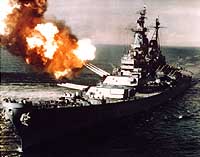 |
|
Photo #: NH 96378 Seoul, Korea U.S. Marines engaged in street fighting during the liberation of Seoul, circa late September 1950. Note M-1 rifles and Browning Automatic Rifles carried by the Marines, dead Koreans in the street, and M-4 "Sherman" tanks in the distance. U.S. Naval Historical Center Photograph. Online Image: 140KB; 740 x 615 pixels |
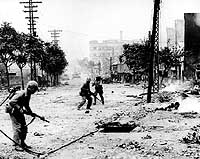 |
|
Photo #: 80-G-420665 Korean refugee woman Carries her belongings in a jug on her head, while fleeing from Pohang, South Korea. Original photo is dated 17 October 1950. Official U.S. Navy Photograph, now in the collections of the National Archives. Online Image: 87KB; 740 x 615 pixels Reproductions of this image may also be available through the National Archives photographic reproduction system. |
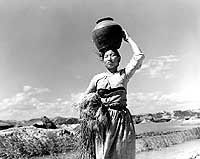 |
|
Photo #: 80-G-420530 Korean War Casualty Evacuation Navy Corpsmen Herald B. Williams, James E. Carr and William N. Shipworth help carry a wounded man from a U.S. Marine Corps HO3S-1 evacuation helicopter to a hospital in Korea. Helicopter is from squadron VMO-6. Original photo is dated 3 October 1950, in which case it was probably taken during Marine Corps operations in the vicinity of Seoul, Korea. Note extensive "Quonset" hut facilities in the distance. Official U.S. Navy Photograph, now in the collections of the National Archives. Online Image: 122KB; 740 x 615 pixels Reproductions of this image may also be available through the National Archives photographic reproduction system. |
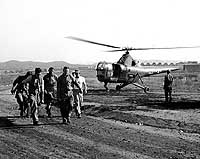 |
|
Photo #: 80-G-422837 Opening of Chinnampo, North Korea, October-November 1950 A LCVP bucks in the well of USS Catamount (LSD-17), during mine clearance operations off Chinnampo, circa November 1950. USS Forrest Royal (DD-872), flagship for this operation, is in the left background. Official U.S. Navy Photograph, now in the collections of the National Archives. Online Image: 92KB; 740 x 610 pixels Reproductions of this image may also be available through the National Archives photographic reproduction system. |
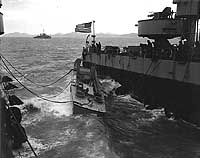 |
|
Photo #: 80-G-420485 General of the Army Douglas MacArthur Boards USS Missouri (BB-63) off Inchon, Korea, 21 September 1950. Official U.S. Navy Photograph, now in the collections of the U.S. National Archives. Online Image: 83KB; 590 x 765 pixels Reproductions of this image may also be available through the National Archives photographic reproduction system. |
 |
|
Photo #: 80-G-420962 USS Philippine Sea (CV-47) Crewmen rolling a 1000 pound bomb across the hangar deck, while rearming from the ammunition ship (AE) in the background, during operations in Korean waters, circa 19 October 1950. Note wooden rails used for moving the bomb. Official U.S. Navy Photograph, now in the collections of the National Archives. Online Image: 102KB; 740 x 630 pixels Reproductions of this image may also be available through the National Archives photographic reproduction system. |
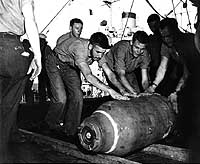 |
For additional special selections of images of the United Nations' Offensive period of the Korean War, with links to broader coverage, see:
For more images of other aspects of the United Nations'
Offensive period of the Korean War, see:
For a precis of our Korean War images, and links to more
comprehensive pictorial coverage of that conflict, see:
| If you want higher resolution reproductions than the Online Library's digital images, see: How to Obtain Photographic Reproductions. |
Text and links revised 17 January 2000